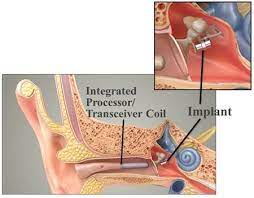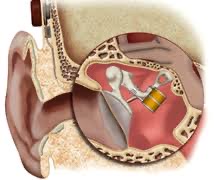

Middle ear implants are small electronic devices that are surgically implanted in the middle ear to improve hearing.
These devices are designed to bypass damaged or malfunctioning parts of the ear and directly stimulate the remaining auditory nerve fibers, providing a more natural hearing experience.
Middle ear implants can be a good option for people who are unable to benefit from traditional hearing aids due to the severity of their hearing loss or because of issues such as chronic middle ear infections or allergies that make ear canal hearing aids impractical.
They can also be a good option for people who have difficulty wearing or adjusting to traditional hearing aids.
There are several different types of middle ear implants, including bone-anchored hearing aids (BAHA) and cochlear implants.
Middle ear implants facilitate patients who are noncompliant with conventional hearing aides, do not receive significant benefit from conventional aides, or are not candidates for cochlear implants.
These devices are generally available in two broad categories: partially or totally implantable using either piezoelectric or electromagnetic systems.
The totally implantable devices provide the user freedom from the social and practical difficulties of using conventional amplification.
Among the numerous reasons for low compliance with hearing devices are acoustic feedback, occlusion effect, frequent battery changes/maintenance, discomfort, infection, irritation, lifestyle restrictions, and repair, loss, or damage.
Faulty circuitry, suboptimal fit, or intrinsic external auditory canal issues can lead to intolerable feedback.
Poor sound quality and difficulty hearing in crowded situations are frequent complaints of those who wear conventional hearing aids.
The social stigma of wearing hearing aids may preclude some from considering the devices.
In addition to the mild to moderate hearing loss from 20 to 60 dB that can be ameliorated by hearing aids, there is the group of patients with hearing loss of approximately 50 to 90 dB who may receive greater benefit from other technologies such as middle ear implants.
These devices are generally available in two broad categories: partially or totally implantable using either piezoelectric or electromagnetic systems.
The Soundbridge is semi-implantable and is composed of an external microphone, sound processor and amplifier, an audio processor, and an internal vibrating ossicular prosthesis.
Sound waves are detected by the microphone located behind the ear and then processed by an implanted receiver.
The vibrating ossicular prosthesis conducts the sound to a magnet surrounded by a coil called the floating mass transducer.
The transducer is attached to the long process of the incus, and the magnet abuts the long axis of the stapes, which causes it to vibrate.
The device uses a battery, and the life depends on usage and device settings.
A typical patient who uses his or her device for 12 to 16 hours a day may need to change the battery about once a week.
94% of patients stated an improvement in overall sound quality over conventional hearing aids.
It is a highly reliable middle ear implant system both surgically and audiologically.
In comparison with conventional hearing aids, a prospective study demonstrated that direct-drive stimulation allows better speech performances than acoustic stimulation for patients with steeply sloping high-frequency hearing losses.
Implanted devices directly stimulate the ossicles and the round window, thereby bypassing the external auditory canal.
Devices that are totally implanted may play an important role by using the eardrum as the microphone and using the pinna and external auditory canal to collect sound in a natural manner.
Most implantable middle ear devices are capable of eliminating feedback, compared to conventional hearing aids.
Improved cosmesis is also noted by means of concealing and miniaturizing most of the device components, and the elimination of the occlusion effect.
The sound quality of implantable hearing devices is at least comparable to conventional hearing aids.
Patient satisfaction and quality of life tend to be substantially improved. With middle ear implants.
